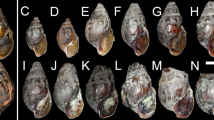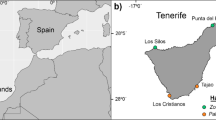Abstract
Throughout Europe the blue mussel Mytilus edulis is dominant in the north while the Mediterranean mussel Mytilus galloprovincialis prevails in the south. Studies from the 1970s to the late 2000′s documented the northward range expansion of M. galloprovincialis in Europe and predicted this trend to continue with climate change. The objectives of this study were to sample predominantly wild mussels (n = 1459) at twenty-four Irish intertidal sites over a seven year period and at three Welsh sites to investigate (a) the abundance and distribution of Mytilus spp., identified molecularly by polymerase chain reaction (PCR), and (b) compare with historical observations, at Irish sites where M. galloprovincialis was observed to be more abundant than M. edulis. Mussels were sampled more than once at certain sites to investigate if there was a temporal effect. The findings of this study indicated that M. edulis was consistently the most abundant species, followed by hybrids and M. galloprovincialis. At certain sites, hybrids were detected while M. galloprovincialis was absent. This finding may indicate transient M. galloprovinicialis populations or input from individuals subtidally. One factor that may be of importance was the anomalous cold winter “polar snaps” (2010 and 2011) that occurred during this study. In addition, heavy precipitation events and subsequent increased freshwater loading in bays and estuaries also occurred during this time period. Future warming climate scenarios have been predicted to facilitate the northwards establishment of M. galloprovincialis, however, nearshore meteorological extremes may have an impact in its larval settlement, establishment and subsequent reproductive output.
Similar content being viewed by others
References
Arnold ML (1997) Natural hybridization and evolution. Oxford University Press, Oxford
Barry JP, Baxter CH, Sagarin RD, Gilman SE (1995) Climate-related, long-term faunal changes in a California rocky intertidal community. Science 267:672–675
Barton NH (1979) The dynamics of hybrid zones. Heredity 43:341–359
Barton NH, Hewitt GM (1985) Analysis of hybrid zones. Ann Rev Ecol Syst 16:113–148
Barton NH, Hewitt GM (1989) Adaptation, speciation and hybrid zones. Nature 431:497–503
Bayne BL (1964) Primary and secondary settlement in Mytilus edulis L. (Mollusca). J Animal Ecol 33:513–523
Beukema JJ (1985) Zoobenthos survival during severe winters on high and low tidal flats in the Dutch Wadden Sea. In: Gray JS, Christiansen ME (eds) Marine biology of polar regions and effects of stress on marine organisms. Wiley, Chichester, pp 351–361
Blegvad H (1929) Mortality among animals of the littoral region in ice winters. Rep Dan Biol Stn 35:49–62
Braby CE, Somero GN (2006) Following the heart: temperature and salinity effects on heart rate in native and invasive species of blue mussels (genus Mytilus). J Exp Biol 209:2554–2566
Branch GM, Steffani CN (2004) Can we predict the effects of alien species? A case-history of the invasion of South Africa by Mytilus galloprovincialis (Lamarck). J Exp Mar Biol Ecol 300:189–215
Brown J, Carrillo L, Fernand L, Horsburgh KJ, Hill AE, Young EF, Medler KJ (2003) Observations of the physical structure and seasonal jet-like circulation of the Celtic Sea and St. George's Channel of the Irish Sea. Cont Shelf Res 23:33–561
Canning-Clode J, Fowler AE, Byers JE, Carlton JT, Ruiz GM (2011) 'Caribbean Creep' chills out: climate change and marine invasive species. PLoS ONE 6(12):e29657
Canning-Clode J, Carlton JT (2017) Refining and expanding global climate change scenarios in the sea: poleward creep complexities, range termini, and setbacks and surges. Divers Distrib 23:463–473
Casal G, Lavendar SJ (2017) Spatio-temporal variability of sea surface temperature in Irish waters (1982–2015) using AVHRR sensor. J Sea Res 129:89–104
Christiansen BO (1965) Notes of the littoral fauna of Bear Island. Astarte 26:1–15
Comensañsa AS, Sanjuan A (1997) Microgeographic allozyme differentiation in the hybrid zone of Mytilus galloprovincialis and M. edulis on the continental European coast. Helg Meeresunters 51:107–124
Crisp DJ (1964) The effects of the severe winter of 1962–63 on marine life in Britain. J Anim Ecol 33:165–210
Dailianis S (2010) Environmental impact of anthropogenic activities: the use of mussels as a reliable tool for monitoring marine pollution. In: McGevin LE (ed) Mussels: anatomy, habitat and environmental impact. Nova Science Publishers Inc, New York, pp 43–72
Dias PJ, Dordor A, Tulett D, Piertney S, Davies IM, Snow M (2009) Survey of mussel (Mytilus) species at Scottish shellfish farms. Aqua Res 40:1715–1722
FAO (2017) Cultured aquatic species information programme: Mytilus edulis. www.fao.org/fishery/culturedspecies/Mytilus_edulis/en Accessed 16 Mar 2020
Fuentes J, López JL, Mosquera E, Vázquez J, Villalba A, Alvarez G (2002) Growth, mortality, pathological conditions and protein expression of Mytilus edulis and M. galloprovincialis crosses cultured in the Ría de Arousa (NW of Spain). Aquaculture 213:233–251
Gardner JPA (1994) The structure and dynamics of naturally occurring hybrid Mytilus edulis Linnaeus, 1758 and Mytilus galloprovincialis Lamarck, 1819 (Bivalvia: Mollusca) populations: review and interpretation. Arch Hydrobiol Suppl 99:37–71
Gardner JPA (1997) Hybridization in the sea. Adv Mar Biol 31:1–65
Geller JB (1999) Decline of a native mussel masked by sibling species invasion. Conserv Biol 13:661–664
GISD (Global Invasive Species Database). 2017. Species profile: Mytilus galloprovincialis. Downloaded from https://www.iucngisd.org/gisd/species.php?sc=102. Accessed 16 Mar 2020
Gosling EM, Wilkins NP (1981) Ecological genetics of the mussels Mytilus edulis and M. galloprovincialis on Irish Coasts. Mar Ecol Prog Ser 4:221–227
Gosling EM, Wilkins NP (1977) Phosphoglucoisomerase allele frequency data in Mytilus edulis from Irish coastal sites: its ecological significance. In: Keegan BF, O’Ceidigh P, Boaden PJS (eds) Biology of benthic organisms. Pergamon Press, London, pp 297–309
Gosling EM (1992) Systematics and geographic distribution of Mytilus. In: Gosling E (ed) The mussel Mytilus: ecology, physiology, genetics and culture. Elsevier, Amsterdam, pp 1–20
Gosling E (2004) Bivalve molluscs: biology, ecology and culture. Blackwell Publishing, New Jersey
Gosling E, Doherty S, Howley N (2008) Genetic characterization of hybrid mussel (Mytilus) populations on Irish coasts. J Mar Biol Assoc UK 88:341–346
Hepper BT (1957) Notes on Mytilus galloprovincialis Lamarck in Great Britain. J Mar Biol Assoc UK 36:33–40
Howard DJ (1986) A zone of overlap and hybridisation between two ground cricket species. Evolution 40:34–43
Hughes RN, Hughes DJ, Smith IP, Dale AC (2015) Oceanography and marine biology: an annual review. CRC Press, Florida
Inoue K, Waite HJ, Matsuoka M, Odo S, Harayama S (1995) Interspecific variations in adhesive proteion sequences of Mytilus edulis, M. galloprovincialis, and M. trossulus. Biol Bull 189:370–375
Jansen JM, Bonga SW, Hummel H (2007) Differential coldshock resistance among acclimated European mussel populations. Mar Freshw Behav Physiol 40:233–245
Jones PD, Osborn TJ, Briffa KR (2001) The evolution of climate over the last millennium. Science 292:662–667
Kristensen I (1957) Differences in density and growth in a cockle population in the Dutch Wadden Sea. Arch Neerl Zool 12:351–453
Lenz M, Ahmed Y et al (2018) Heat challenges can enhance population tolerance to thermal stress in mussels: a potential mechanism by which ship transport can increase species invasiveness. Biol Invasions 20(11):3107–3122
Lewis J, Seed R (1969) Morphological variations in Mytilus from southwest England in relation to the occurrence of M. galloprovincialis. Cah Bio Mar 10:231–253
Lima FP, Ribeiro PA, Queiroz N, Hawkins SJ, Santos AM (2007) Do distributional shifts of northern and southern species of algae match the warming pattern? Global Change Biol 13:2592–2604
Loomis SH (1995) Freezing tolerance of marine invertebrates. Oceanogr Mar Biol Annu Rev 33:337–350
Mayr E (1963) Animal species and evolution cambridge. Harvard University Press, Cambridge
Moore WS (1977) An evaluation of narrow hybrid zones in vertebrates. Q Rev Biol 52:263–277
Noone S, Murphy C, Coll J, Matthews T, Mullan M, Wilby RL, Walsh S (2015) Homogenisation and analysis of an expanded long-term monthly rainfall network for the Island of Ireland (1850–2010). Int J Climatol 36:2837–2853
Ozer A, Guneydag S (2014) First report of some parasites from Mediterranean mussel, Mytilus galloprovincialis Lamarck, 1819, collected from the Black Sea coast at Sinop. Turk J Zool 38:486–490
Page HM, Hubbard DM (1987) Temporal and spatial patterns of growth in mussels Mytilus edulis on an offshore platform: relationships to water temperature and food availability. J Exp Mar Biol Ecol 111:159–179
Perry AL, Low PJ, Ellis JR, Reynolds JD (2005) Climate change and distribution shifts in marine fishes. Science 308:1912–1915
Rawson PD, Hilbish TJ (1998) Asymmetric introgression of mitochondrial DNA among European populations of blue mussels (Mytilus spp.). Evolution 52:100–108
Riginos C, Cunningham CW (2005) Local adaptation and species segregation in two mussel (Mytilus edulis x Mytilus trossulus) hybrid zones. Mol Ecol 14:381–400
Saavedra C, Donald TS, Stanwood RR, Zouros E (1996) Species-specific segregation of gender-associated mitochondrial DNA types in an area where two mussel species (Mytilus edulis and M. trossulus) hybridize. Genetics 143:1359–1367
Sanjuan A, Zapata C, Alvarez G (1994) Mytilus galloprovincialis and M. edulis on the coasts of the Iberian Peninsula. Mar Ecol Prog Ser 113:131–146
Sagarin RD, Barry JP, Gilman SE, Baxter CH (1999) Climate related change in an intertidal community over short and long time scales. Ecol Monogr 69:465–490
Sarver SK, Foltz DW (1993) Genetic population-structure of a species complex of blue mussels (Mytilus spp.). Mar Biol 117:105–112
Schneider KR (2008) Heat stress in the intertidal: comparing survival and growth of an invasive and native mussel under a variety of thermal conditions. Biol Bull 215:253–264
Seed R (1969) The ecology of Mytilus edulis L. (Lamellibranchiata) on exposed rocky shores I breeding and settlement. Oecologia 3:277–316
Seed R (1974) Morphological variations in Mytilus from the Irish Coasts in relation to the occurrence and distribution of M. galloprovincialis Lmk. Cah Biol Mar 15:1–25
Seed R, Suchanek TH (1992) Population and community ecology of Mytilus. In: Gosling EM (ed) The mussel Mytilus: ecology, physiology, genetics and culture. Elsevier, Amsterdam, pp 87–169
Shurova N (2001) Influence of salinity on the structure and the state of bivalve Mytilus galloprovincialis populations. Russ J Mar Biol 27:151–155
Skibinski DOF, Beardmore JA, Cross TF (1983) Aspects of the population genetics of Mytilus (Mytilidae; Mollusca) in the British Isles. Biol J Linn Soc 19:137–183
Smidt ELB (1944) The effects of ice winters on marine littoral faunas. Folia Geogr Dan 2:1–36
Steele CJ, Dorling SR, von Glasow R, Bacon J (2013) Idealized WRF model sensitivity simulations of sea breeze types and their effects on offshore windfields. Atmos Chem Phys 13:443–461
Suchanek TH, Geller J, Kreiser B, Mitton J (1997) Zoogeographic distributions of the sibling species Mytilus galloprovincialis and M. trossulus (Bivalvia: Mytilidae) and their hybrids in the north Pacific. Biol Bull 193:187–194
Tang Q, Zhang X, Yang X, Francis JA (2013) Cold winter extremes in northern continents linked to Arctic sea ice loss. Environ Res Lett 8:014036
Toro JE, Thompson RJ, Innes DJ (2002) Reproductive isolation and reproductive output in two sympatric mussel species (Mytilus edulis, M. trossulus) and their hybrids from Newfoundland. Mar Biol 141:897–909
Tyler-Walters H, Seed R (2006) "The Marine Life Information Network" (On-line). at https://www.marlin.ac.uk/species/detail/1421 Accessed 16 Mar 2020
Van Erkom SC, Griffiths CL (1992) Physiological energetics of four South African mussel species in relation to size, ration and temperature. Comp Biochem Physiol 101:779–789
Walsh PS, Metzger DA, Higuchi R (1991) Chelex 100 as a medium for simple extraction of DNA for PCR-based typing from forensic material. Biotechniques 10:506–513
Williams RJ (1970) Freezing tolerance in Mytilus edulis. Comp Biochem Physiol 35:145–161
Zagata C, Young C, Sountis J, Kuehl M (2008) ``Mytilus edulis`` (Online), Animal diversity web. https://animaldiversity.org/accounts/Mytilus_edulis/ Accessed 16 Mar 2020
Acknowledgements
This study was part-funded by the SUSFISH (Grant Agreement No. 244132) and BlueFish (Grant Agreement No. 80991) Projects under the European Regional Development Fund (ERDF) through the EU Ireland/Wales Interregional (INTERREG) Programme. A cross-border programme investing in the overall economic, environmental and social well-being of Ireland and Wales. The authors would like to thank the reviewers for their positive response to this study and for providing interesting comments, thoughts and very relevant references.
Author information
Authors and Affiliations
Corresponding author
Additional information
Publisher's Note
Springer Nature remains neutral with regard to jurisdictional claims in published maps and institutional affiliations.
Rights and permissions
About this article
Cite this article
Lynch, S.A., Coghlan, A., Leary, B.O. et al. Northward establishment of the mediterranean mussel Mytilus galloprovincialis limited by changing climate. Biol Invasions 22, 2725–2736 (2020). https://doi.org/10.1007/s10530-020-02294-6
Received:
Accepted:
Published:
Issue Date:
DOI: https://doi.org/10.1007/s10530-020-02294-6









